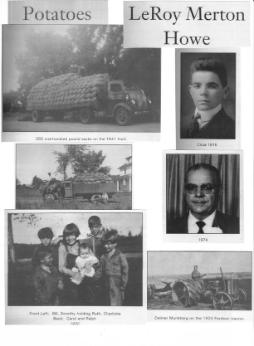
Who loves potatoes? We all do. Baked potatoes are my favorite! Back in the early days potatoes were grown only a few miles away, in Brooklyn Center. The most successful potato farmer of all was Roy Howe, a man referred to as “the potato king.”
Roy’s parents, Everett and Emma Howe, settled in Brooklyn Township in the early 1850s. They started the first store and post office, but were mainly farmers who appreciated the sandy soil in the area, after farming the rocky land in Maine. They had four children, Frank, Charlotte, Vera and Le Roy (Roy), with Vera passing away at age 16. They had all gone to school in Brooklyn Center and Roy went to North High and then to the U of M Farm School.
Roy met Myrtle Hartkopf at a dance in Camden, and they were later married in Robbinsdale. Myrtle was brought up on a 40-acre farm in Brooklyn Township where her folks raised crops to feed cows and pigs. So she was already an outdoors girl used to farm life, and a perfect mate for Roy.
Their crop was, of course, potatoes. Brooklyn Center was an ideal place with sandy soil and next to large populated areas, which gave them a ready market. Now, here is where the benefit of having a large family comes in. There were six children — Dorothy, Ralph, Carol, Charlotte, Bill and Ruth. So while the plows were getting the fields ready for planting, the women and children were cutting up the seed potatoes. These were brought in from the Red River Valley in the fall and stored in root cellars all winter.
In early years, the Howes grew mostly the white variety called Early Ohio. In later years they grew the Waseca Red variety. These potatoes were cut one at a time by hand with a sharp knife fastened to a table or chair, leaving at least one eye on each piece of potato. It was then sprinkled with sulfur and later with pyrax talc to induce healing, and then packed in 60 lb. burlap bags. The Howes carried those 60 lb. bags up 20 steps from the root cellar, loaded them onto a truck along with fertilizer and sent them to the field for planting.
The planting was done with four horses pulling a two-row planter. Delmer Munkberg was the main operator of the potato planters and straight rows were his trademark. Roy owned 115 acres on his homestead, then in 1939 purchased the Sinclair farm at 5000 63rd Ave. N. adding another 160 acres. He was also one of the first growers to irrigate acres of potatoes. This was needed because of a lengthy drought. There were 200 ft. wells drilled on each of Roy’s farms with 30 horsepower electric motors and pumps. The heavy galvanized steel irrigation pipes had to be moved every three hours around the clock to get the necessary amount of water.
The children had their work cut out for them. All six, plus some daytime help, managed this project. They remembered moving those heavy water-filled pipes, which was especially difficult at 2 a.m. on cold mornings. The potatoes were about ready for harvest on the 4th of July. While Roy conducted all the business details, Myrtle was in charge of the grading, Dorothy helped out in the office, Carol helped out in the office and with the grading, Charlotte was on the cooking detail, and Ralph, Bill and Ruthie were either on the potato digger managing picking crews or grading. Everyone had a job! Roy was of the mind that work was the cure for almost all ills!
The picking crews were made up of kids who lived in the area and they earned from 3 to 5 cents a bushel. Their baskets were loaded on to slow moving trucks which hauled approximately 110 bushels to the grader. The #1 potatoes were put in 100 lb. burlap bags and hand-sewn shut. At the tender age of 15, son Ralph delivered potatoes all over the state. Their brand name was “Best Buy” but changed later to “Best Bet.”
The Howes went on to have a bushel-basket manufacturing plant, a large fertilizer manufacturing plant, increased acreage in Champlin and Henriette, advanced equipment, bigger trucks, and a spur railroad line that Earle Brown once had, on the tracks on 49th St., on the border of Minneapolis and Brooklyn Center. This potato business had been tremendously successful, but Roy Howe could not have done it without the diligence and cooperation of every member of his family!
Note: Taken from the book Howe’s Best Bet, The Life and Times of Roy and Myrtle Howe and Their Family, and from information supplied by Keith Nordby.